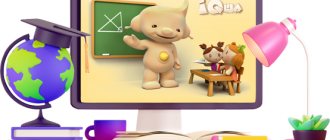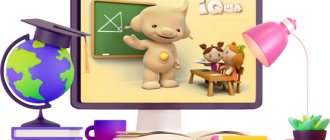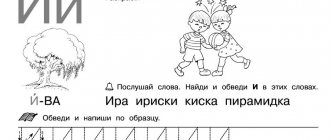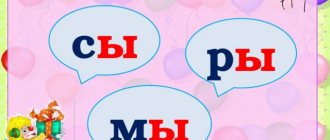Certificate for children
Learning to read is one of the most important tasks for a preschooler. Having mastered this skill, the child will be able to independently explore the world with the help of books and find answers to his questions.
Development and education of children from 2 to 11 years old in a playful way
Start practicing right now
Start practicing
However, this is not so easy to learn. We suggest using game techniques that will help turn a difficult learning process into an exciting quest.
Literacy training in the senior group
It is at the age of 5-6 years that children usually begin to actively teach literacy and spend time developing speech: distinguishing sounds and letters, reading individual words and sentences, putting emphasis.
Preschoolers learn to find the right words to name objects in pictures, make sentences, and draw diagrams of words.
Children also train and prepare their hands for writing: they draw and paint a lot, shade, trace the contours of objects, and learn to write letters little by little.
Games and play activities used in literacy classes
GAMES AND GAME EXERCISES USED
IN LITERACY CLASSES
Remember the words of the children's song, “You have to have fun learning in order to study well.” Academician N. Bekhtereva, as if clarifying this idea, says that “With emotional limitation (dullness), the brain functions at a level significantly lower than optimal.” Maybe that’s why children’s desire for learning is so great, which is close to the natural form of their everyday existence - play.
It is well known that play occupies a special place in the life of a preschooler, leading activity at this age. On the one hand, play itself is of particular importance for the development of a child. On the other hand, play and play techniques are an integral form of learning for preschool children.
All learning takes place in a fun and imaginative context of situations that are understandable to the child.
We use all the games listed below in our work with children in the classroom, which is why we provide their detailed descriptions, rules and necessary material for them. This makes our task easier when writing notes in which we only indicate the name of the game.
Games with sounds and letters
Game exercise “Body – letter” - o
original way to memorize letters. The child depicts the letter using his entire body. You can make such “Body riddles”, and the children guess what letter it is. Then you can change roles, the child will make a guess. and you guess.
Similar exercises can be performed using your hands and fingers.
Poems about letters
Poems about letters, which describe the external characteristics of the letter, can also help in memorizing letters. It is useful not only to read such poems to children, but also to memorize them.
We learned the letter "A"
Admire what it's like!
And it’s easy to recognize her -
He puts his legs wide.
There are a lot of similar quatrains in the book “Entertaining ABC Studies” (edited by G.P. Popova, V.I. Usacheva).
Game "Collect the letter."
A game based on the principle of cut pictures. The game promotes not only the memorization of letters, but also the development of visual and effective thinking, will help prevent errors in writing letters (mirror writing, writing “upside down”, etc.)
For this game you need to prepare cards with letters, cut them into two, four, six, eight parts. The cutting should be from the simplest to the most complex. To avoid confusing the details of the letters, it is better to make them in different colors. Don't forget to ask and say what letter you got!
Game "Pattern of letters".
This is a kind of “spatial riddle” made of letters. To make them, you will need a set of colored paper or cardboard. Fold a piece of paper vertically and horizontally. On the resulting quarter of the sheet, draw a letter so that its outline occupies as much space as possible. Cut out the letter without unfolding the sheet, unfold the sheet. Show your child the resulting pattern. Ask, what letter did the pattern come from? In front of the child’s eyes, fold the sheet in four and show the answer.
You can also entrust the child himself with checking the guess. This game helps prevent spatial errors in writing letters in the future (mirror writing, writing “upside down”). The game develops spatial and imaginative thinking.
Game "Find and Underline".
This game requires any text in large font. Invite your child, carefully looking through the text, to find and underline the desired letter. Don't forget to ask what letter is he looking for? The letter can be circled or crossed out, etc. If such tasks are successfully completed, you can suggest looking for two letters at the same time and highlighting them in any way. The task is useful at all stages of learning (even for children who read, as it also trains attentiveness).
Game "Complete the letter."
Write only the elements of the letters on a piece of paper. Ask your child to guess what letters you wanted to write? Offer to add the missing elements to make a letter. The game develops imagination and will help prevent mistakes when writing letters.
Game “Which letters are hidden?”
Invite your child to guess which letters are hidden in these pictures. It is better to draw tasks on separate sheets. If the child cannot recognize a letter, trace it with the blunt end of a pencil, this will help him highlight the letter against the general background.
The task develops visual perception.
Game "Fourth wheel"
.
Children are offered cards with four letters, one of which is extra. The basis for classification can be the characteristics of letters - vowels - consonants.
For example (A O U R), (M P A K), etc.
Game "Guess the word"
(“Cryptographers”). Various objects are drawn on the card. Using the first letters of the pictures you need to read the encrypted word.
Puzzles, charades, crosswords
. Lessons are compiled based on the program material. Words can be encrypted using riddles, pictures drawn next to them, etc.
Game technique "Accordion".
Used when familiarizing yourself with all vowel sounds (a, o, u, y. i. e). Children are asked to stretch the vowel sound, imitating playing the harmonica (they clench their fists and stretch them, while pronouncing the vowel sound (a-a-a-a). The main goal of the exercise is to give children the idea that vowels are stretched.
Game exercise “Sing a song with sound.”
First, the adult sings a song with a vowel sound to the tune of any familiar melody, and then asks the child to sing his own song. This exercise makes it easier to understand the main characteristics of vowel sounds (drawn and sung) and understand their main difference from consonant sounds.
Game "What did you hear?"
It is used in almost every lesson when a new sound is introduced. Children are encouraged to close their eyes and listen to who hears what. The adult clearly, exaggerating the sound, pronounces it several times. Children open their eyes, the adult addresses each child in turn:
- What did you hear? Repeat? This exercise helps determine how clearly and correctly the child can reproduce the sound he hears.
Game "Fold a letter from sticks."
You can use plasticine, wire, etc.
Game “Who is the most attentive” (with clapping).
Children are asked to listen to words with a given sound. As soon as they hear the desired sound in the word, they need to clap their hands.
Game "Beacon"
. Children light up their beacons when they hear a vowel among the individual sounds being spoken (at the teacher’s choice). The beacon could be a red card.
Game "Magic Chest"
(author's).
The children are given chips. It is explained that these are enchanted words. The condition of the game is to collect words for a given sound in a chest. The game begins with the words:
"Chok, chok, chok, chok
Open up, little chest."
The child says the word and puts the chip in the chest. If the word is named incorrectly, the chest closes in front of the child. At the end of the game, it is calculated how many words all the children came up with.
There are many options for the game, since you can put anything you like into the chest: words with a given sound, words with one syllable, two syllables, etc.
Game "The letter is lost."
An object is drawn in the picture and the name of this object is written next to it with one letter missing. Children are asked to find and identify the missing letter.
Game "The letters ran away."
The card depicts an object, next to it there are empty drawn cells for letters. Children are asked to form a word from the letters and return them to their place.
Game "Syllable Lotto" -
make words from syllables. Children are given cards with open syllables (SG) written on them. From these, children make words. The one who composes the most words wins. The number of cards a child has can increase from 3 to 8 or more.
Game "Typesetter" -
form all possible words from the letters of the given word. A word is made on a typesetting canvas from the letters of the cut alphabet, and the children read it. Then it is proposed to create new words from these letters, for example, from the word “shop” (magician, gas, Zina).
Game “Letters went to parade, letters lined up in a row” (author’s).
Letters of different sizes are cut out of colored cardboard. It is better if each word is a different color, then the letters are easy to sort. The child is given a task - to line up the letters from the largest in size to the smallest and read what word it turns out to be.
Game "Come up with words with sound."
Children are asked to come up with words with a given sound. A simple version of the game is without indicating the location of the sound in a word, a more complex one is to come up with words with a given sound (at the beginning of the word, at the end, in the middle).
Game "Sound Chain".
Teach children to identify the first and last sounds in a word.
The first player names a word, the next player selects his word, where the initial sound will be the last sound of the previous word. The game is continued by the third child, etc. You cannot repeat words. The main task of the game is not to break the chain of words. The player who made a mistake pays a forfeit (performs some task).
Another version of this game is with pictures. The first word-picture is marked with a red flag, and the game begins with it. Then the children look for the second word-picture, etc. You can start the game with 3-4 pictures. Gradually increasing the chain of words.
Game “Where is the sound hidden?” (with models).
The teacher has a set of subject pictures. Each child has a card divided into three parts (a model diagram of the location of a sound in a word) and a chip. The teacher shows the children an object picture, the children name the word. Next, each player places a chip on his card where the desired sound is located - at the beginning, middle or end of the word.
Game "Pyramid" (dividing words into syllables).
Purpose of the game: to train children in determining the number of syllables in words. Each child has a playing field - an image of a pyramid of squares (in 3 rows): at the bottom there are 3 squares - for three-syllable words, above - 2 squares - for two-syllable words, and at the top one square - for one-syllable words.
The teacher invites the children to build a pyramid of pictures; to do this, they need to pronounce the word syllable by syllable and determine where to put the picture.
Game "To each his place."
Each player has a set of subject pictures and three cards, divided into three parts (a diagram-model of the location of a sound in a word). The first, second and third squares of each card are filled in. The teacher suggests sorting picture words into patterns depending on where the desired sound is located.
Game "Train" (author's).
Purpose of the game:
consolidate the skill of synthetic reading of open syllables. Children are invited to ride a musical train. The driver (child) is selected. The teacher announces:
"Attention! Attention! The musical train departs from the first (second, third, etc.) track. The driver is Mashenka.”
The children say in chorus the words: “The driver is taking us,
Sings songs loudly."
The child, moving a pointer across the table, sings (reads) the syllables in a horizontal plane. The game goal of the game is as follows - the faster the child reads, the faster his train moves. After the child has read the entire horizontal row, you can ask him - What vowel were all the songs on the train with?
Game “Who Lives in the House?”
Purpose of the game: to train children in selecting words with a certain sound.
Images of houses with windows where pictures can be inserted. There is a letter on the roof of the house. On the board or for children there are pictures depicting various animals and birds. Children are invited to move into the house only those animals whose names contain a given sound.
Game “Who is the gift for?”
(For Queen or Princess).
The purpose of the game is to train children in differentiating hard and soft consonants. Silhouettes of drawn Queen and Princess. The Queen's dress is blue, the Princess's is green. Children have pictures of objects. The Queen and Princess invite the children to visit, the children take gifts—pictures. If the given sound sounds soft in a word, it is a gift for the Princess, and if it sounds hard, it is a gift for the Queen.
Game "Flower Shop".
Purpose of the game: to train children in dividing words into syllables. Fix the names of colors in the children's dictionary. For the game you need postcards, pictures of flowers, the names of which consist of one, two, three and four syllables. This is a “flower shop”, and the red chips are money. Anyone can buy any flowers, they just need to pay the seller correctly, that is, give as many chips for each flower as there are syllables in this word. The one who bought the most flowers wins.
Game “Carry On! Just a word for you."
The goal of the game is to come up with words using a given syllable. You can play with the ball.
The teacher names the first syllable and throws the ball to the child. The child must say the entire word and throw the ball to the leader. If the child makes a mistake, the ball is returned to him.
Game "Shop".
Purpose of the game: to strengthen children’s skill in reading words, to determine the level of reading mastery of each child. The materials for the game are sets of cards with words. An object is drawn on one side. On the other hand, a word is written that denotes this object. The game is used in almost every lesson, but the set of words changes each time. It is selected depending on the goals of the lesson and program content. Only one thing remains unchanged - this is the main condition of the game “Whoever reads a word buys it.”
Game "Confusion" (syllables)
Syllables are located on the board. written on cards. Open syllables (SG) are used. Nearby are pictures starting with these syllables. The child is asked to connect the syllable with a suitable picture.
The game “Who will go and find a friend.”
(author's).
Goal: to consolidate the skill of reading words-names, knowledge of the rule - people's names are written with a capital letter. Words with names are written on cards measuring 15x20 cm; on the reverse side there is a picture of a boy or girl. Children go out, choose any word, read it. If the name is read correctly, the child keeps the card. That one wins. who will read more words?
Game “Find the picture for the diagram”
.
There are three large cards on the board with diagrams of the location of sounds in a word (one cell is shaded at the beginning, middle and end of the diagram). Children have pictures with objects for a given sound. The teacher asks you to pronounce the word and determine where the sound is? Each child comes out and places their card next to the appropriate diagram.
Game exercise “Bird”
(author's) - to consolidate the skill of reading consonants. The manual “Bird” is used. Children play this game with their fingers. The left palm is a feeder with grains, the fingers of the right hand are gathered into a fist, the index finger is the beak of the mother bird. A game moment is introduced - a poetic text about a mother bird
The mother bird has arrived
She began to peck the grains.
Began to peck grains
And name the consonants (M, N.K, S, T, etc.) depending on the sound that is being studied at the moment.
The bird's beak (the index finger of the right hand) hits the palm, and with each movement a short consonant sound is pronounced. This game exercise allows you to prevent the most important mistake and difficulty children have in pronouncing consonants - without an overtone (E).




